|
Printables |
PowerPoints |
Online exercises |
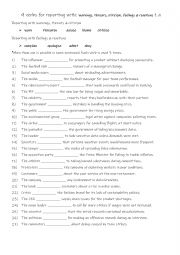
|
9 verbs for reporting with warnings, threats, criticism, feelings & reactions 1 a
First, students need to familiarise themselves with the verbs and check their meaning and use. Then they read the sentences to see which verb is needed to complete the sentence. Each verb is used 3 times! Answers on page 2.
Level: intermediate
Age: 10-100
Type:
Downloads: 108
|
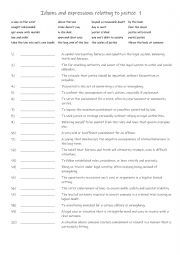
|
B1+-C1 Idioms and expressions relating to justice 1
First, students need to familiarise themselves with the 20 idioms and expressions and their meanings. Then they read the definitions to see which one is being described and write that word in the space provided Answers on page 2.
Level: intermediate
Age: 12-100
Type:
Downloads: 109
|
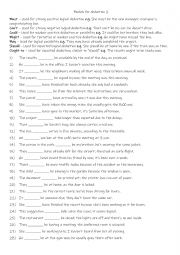
|
A2-B1 7 modals for deduction 2
First, students need to familiarise themselves with the modals and their use. Then they read the sentences to see which one is needed to complete the gap-fill. Each modal is used 4 times! Answers on page 2.
Level: elementary
Age: 9-100
Type:
Downloads: 113
|
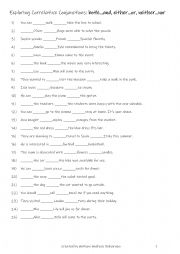
|
A2 -B1 Exploring Correlative Conjunctions both...and, either...or, neither...nor
These conjunctions help students clearly express relationships between ideas or items in a sentence. They provide a way to connect words, phrases, or clauses in a balanced and structured manner.Mastery of correlative conjunctions can enhance students overall writing and speaking skills. They add variety and sophistication to your language, making y...
Level: intermediate
Age: 10-100
Type:
Downloads: 117
|
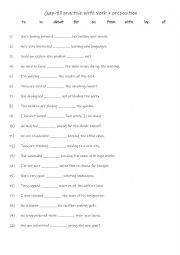
|
A2+-B1 Gap-fill practise with verb + preposition (1)
The gap-fill exercise provided is suitable for A2+-B1 level students. It involves common prepositions and phrases that are often used in everyday contexts, making it appropriate for learners who have a solid grasp of basic grammar and are ready to tackle more nuanced uses of prepositions. Answers on page 2.
Level: intermediate
Age: 10-100
Type:
Downloads: 109
|
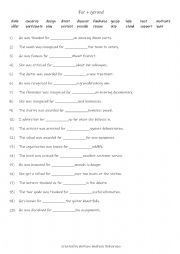
|
A2+-B1 reasons for doing something using: for + gerund (2)
First, students need to familiarise themselves with the 20 verbs and their use. Then they read the sentences to see which one is needed to complete the gap-fill. Answers on page 2.
Level: intermediate
Age: 10-100
Type:
Downloads: 120
|
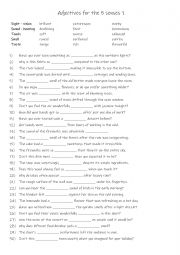
|
A2+-B1 15 adjectives for the 5 senses 1
Students should learn sensory adjectives to expand their descriptive vocabulary and enhance their communication skills. These words enable vivid and engaging descriptions, bringing writing and speech to life with clarity and detail. Adjectives like "picturesque," "deafening," or "tangy" help students express nuanced observations, while emotive term...
Level: elementary
Age: 8-100
Type:
Downloads: 110
|
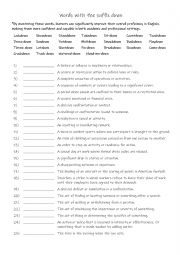
|
B1-B2 Words with the suffix down
Students read the definitions and match them with the words in bold. By mastering these words, learners can significantly improve their overall proficiency in English, making them more confident and capable in both academic and professional settings. Many of these words are used frequently in everyday English, media, and professional contexts, so k...
Level: intermediate
Age: 12-100
Type: worksheet
Downloads: 110
|
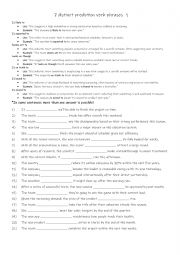
|
7 distinct prediction verb phrases 1
These phrases help express different levels of certainty about future events. "Is likely to" suggests something will probably happen based on evidence, while "is expected to" refers to something predicted or planned. "Seems set to" indicates something is prepared to happen soon, and "looks as though" is used when something seems probable based on c...
Level: intermediate
Age: 12-100
Type:
Downloads: 114
|
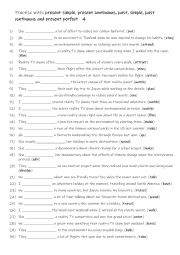
|
A2-B1 Practise with present simple, present continuous, past, simple, past continuous and present perfect 4
Students at A2-B1 level should practise the present simple, present continuous, past simple, past continuous, and present perfect tenses as they form the foundation of clear and effective communication. These tenses enable learners to discuss routines, habits, and facts, describe ongoing actions, recount past events, and share experiences or achiev...
Level: elementary
Age: 8-100
Type:
Downloads: 131
|
|
|
|
|












